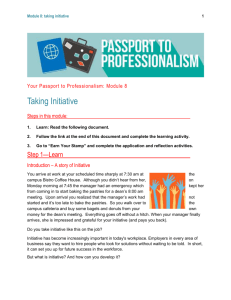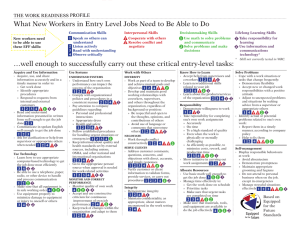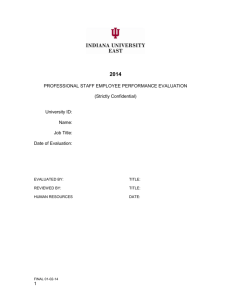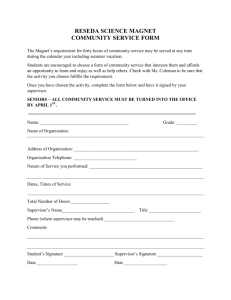CONSTRUCTING ORGANIZATION-SPECIFIC JOB ATTITUDE SURVEYS IOOB Conference, March 14, 2010
advertisement
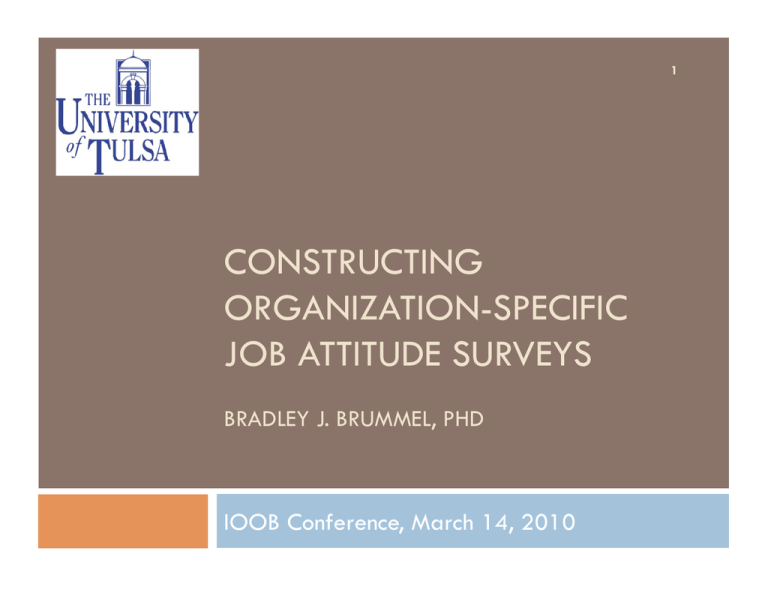
1 CONSTRUCTING ORGANIZATION-SPECIFIC JOB ATTITUDE SURVEYS BRADLEY J. BRUMMEL, PHD IOOB Conference, March 14, 2010 Overview 2 Job Attitude Survey Options Organizational Purpose Available Constructs Approaches Theoretical Rational Assessing Scale Functioning Dimensionality Functioning Utility Examples Job Attitude Survey Options 3 Take one from the empirical literature Organizational Commitment Perceived Organizational Support Employee Engagement Pay a consulting company for their scale and norms Job Descriptive Index Gallup 12 Pay an external consultant to make a scale Expensive Build your own scale Three hours and a bottle of wine? (Burisch, 1984) Organization-specific nuances Organizational Purposes 4 Employee Understanding Type of Attitudes Source/Target of Attitudes Employee Development Change Management See effects of change Watch for problems Anonymous/Confidential? Depends on purpose Affect response rates/truthfulness Available constructs 5 Job Satisfaction Organizational Commitment Task Identity, Task Importance, Skill Variety, Autonomy, & Feedback Employee Engagement Types Perceived Organizational Support Job Characteristics Types Organizational Justice Facets To include OCBs or not? Leader-Member Exchange Organizational Trusts Burnout Two Basic Approaches 6 Theoretical Pick Constructs of interest Write/adapt items to measure those constructs Analyze scale according to your survey design Rational Obtain relevant employee attitudes Focus Groups Interviews Write appropriate items See what happens … Empirical? Give employees a number of scales and pick the best items Assessing Scale Functioning 7 Using Statistics to Understand your Scales Internal Consistency Inter-item Correlations Factor Analyses Structural Equation Models Path Analysis Model Fitting v. Model Testing Multiple Regression Exploratory v. Confirmatory Dominance Analysis (Budescu, 1993) Areas Dimensionality Functioning Utility Dimensionality 8 Theoretical Attitude type (Harrison, et al., 2006) Attitude source/target Supervisor, work itself, turnover, etc. Implications of having multiple dimensions More analyses Need to describe results by scale dimension Scoring might be an issue Factor scoring worthwhile? Oblique factors might work similarly Functioning (Nomological network) 9 Positive and Negative Affect Turnover Intentions Job Satisfaction OCBs Organizational Position Your Scale CPWBs Demographic Variables Employee Engagement Supervisor-Rated Performance Job Characteristics Utility 10 What can you expect your survey to do? Predict outcomes Turnover OCBs CPWBs Task Performance Work-life Balance Program usage Which research findings can you confidently borrow? Compare scale overlap empirically Examine correlation patterns Be mindful of sampling issues Example: Predict Attrition 11 Spectrum HR Supervisor Survey (5 scales) Awards/recognition Promotion /raises Job withdrawal behaviors Performance Pay Employee Survey (4 scales) Satisfaction Work itself Supervisor, Coworkers, Pay, Organization Commitment/Engagement Turnover intentions / Job search behavior Use Compare supervisor and employee scales for predicting turnover Find best Predictive Equation Intervene for people with high scores Example: Predict Attrition 12 Supervisor Items This person has received awards from the organization for his/her performance. It is likely that this person will be promoted in the near future. This person’s desk or personal areas are filled with personal effects and pictures. This person puts extra effort into projects and other work when necessary. This person has recently received a substantial raise in pay. Employee Item My work has a significant impact on the world. I often receive feedback on performance at work. I have a good chance for advancement at this organization. I am proud to be a member of this organization. I have posted my resume online. Example: Employee Engagement 13 Affective I am satisfied with my current job I am emotionally connected to my coworkers This organization feels like a family. I like my supervisor as a person. I enjoy the work that I do. I feel fulfilled in this occupation. Cognitive I am committed to this organization I am compensated fairly for the work that I do. I am provided with adequate resources to do my job. I owe this organization my support. There are opportunities for advancement at this organization. I plan to remain with this organization. Behavioral I spend my own time developing workrelated knowledge and skills. I do more than my assigned work to accomplish organizational goals I defend and promote my organization to people outside the organization. I would remain with this organization through economic hardship. I teach coworkers my knowledge and skills. I provide coworkers with personal support. Example: Employee Engagement 14 5 point Strongly disagree to Strongly agree The gallup measure has a true score correlation with “how satisfied are you with your current job” of .91 (Harter, Schmidt, & Hayes, 2002) Alpha Reliability: Affective satisfaction, coworkers, organization, supervisor, work itself, & occupation Cognitive My scale = .90 Gallup = .87 commitment, pay, resources, promotions, normative & continuance Behavioral 2 items each on personal support, org support, & conscientious initiative My Scale Gallup Gallup engagement Withdrawal cogni;ons ‐0.44 ‐0.26 OCBs 0.70 0.74 CPWBs Task Performance Jus;ce Percep;ons ‐0.45 ‐0.41 0.49 0.57 0.65 0.69 Job Sa;sfac;on 0.77 0.69 POS 0.76 0.76 LMX 0.71 0.76 0.81 Questions? 15 Practical Theoretical Specific Thanks!

